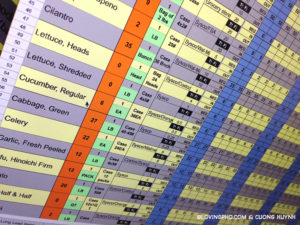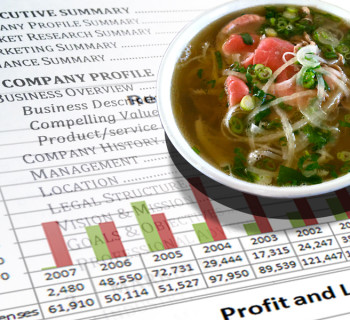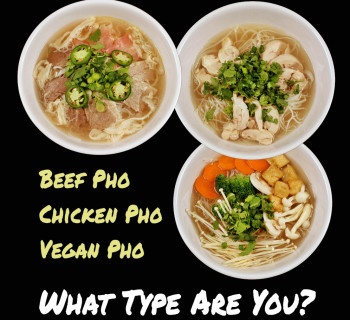Updated 03-25-19. A good inventory system can make or break any restaurant, and pho restaurants are no exceptions.
Most new and existing pho restaurant owners pay no attention to an inventory system until it's too late. By the time they think they need an inventory system, they'd potentially have lost thousands of dollars already. And the sad part is what happened in the past is unrecoverable. The lesson here is get organized and implement an inventory system before you open for business. If this was not done, then the second best thing to do is: don't waste another day. Start one now.
 This is part 1 of a series of articles on pho restaurant inventory system. For those who know they need one but don't know where to start, you will find this article very useful. For those who are not aware or not sure they need one, I hope this post convinces you that you do need one.
This is part 1 of a series of articles on pho restaurant inventory system. For those who know they need one but don't know where to start, you will find this article very useful. For those who are not aware or not sure they need one, I hope this post convinces you that you do need one.
But being aware that you need an inventory system is not enough. You need to know how to use it and get the most out of it. No two pho restaurants are exactly the same, hence each restaurant owner needs an inventory system that actually works for his/her business.
Let's first start with some basics.
What's The Big Deal About Having An Inventory System?
As a pho restaurant owner you need to know what you have in storage at all times, and when you need to order, and what supplies to order.
Having a good inventory system and knowing how to use it will help you stop waste, eliminate shrinkage, optimize inventory cost, and maximize profits. These are the direct benefits.
Some indirect benefits include:
- Optimized use of labor resources, including minimizing labor cost, and
- Maintaining high food quality/customer satisfaction.
These are called indirect benefits because at first glance the may seem unrelated to an inventory system. But think about the following:
- If you have an organized inventory system, your crew doesn't have to run around verifying that you're out of something and having to look for replacement ingredients, or can't serve the menu item at all.
- When the above happens, this will result in substandard dish that fails to meet customers' expectation, or worse yet, you have to eighty-six a menu item and tell the customer she can't have what she wants.
So not having a good inventory system and/or not implementing it correctly can really impact your operation negatively, and definitely your bottom line as a result.
What Is Inventory and What Is Par?
Initially during the formative stage of a new pho restaurant, most owners love to talk about the food, the menu, the business name, the look of the dining room, equipment for the kitchen, etc. It's always after grand opening when operation begins that they run into under- or over-stocked situations.
In restaurant lingo, they have problems with inventory and inventory par levels. Once this begins to happen, the domino effect can propagate to other areas of the operation causing further and new problems. Before we go on, let's take a look at two key definitions:
- Inventory is a complete list of all items and their quantities you have on hand at any one time.
- Par is the minimum amount of each item you need on hand to meet typical production/service demands between vendor deliveries.
Conceptually inventory is simple to understand and do: Have an inventory system to track what you have on hand, and use par levels to know when you're running short of something and need to order more.
This leads us to the next point, which is quite important.
Pho Restaurant Is Both A Retail And A Manufacturing Business
To be clear, a pho restaurant owner also needs to realize the following: While a restaurant may be considered a retail business where you sell directly to consumers, in the back of the house (BOH) you are actually running a "manufacturing" business.
Keeping this clear in your mind will help you understand what your inventory system should be and how to best use it. In a pure retail business, you sell "ready-made" goods that have a one-to-one correlation between your inventory and your sales.
For example, if you're selling sports shoes, then for each pair of shoes you sell out the front door, you subtract from your inventory an exact pair (brand, color, size, etc.) from your inventory; the exact pair that you've received through your back door at some earlier time. What you receive in your back door, you sell exactly 100% of it to the customers.
But it's not so in restaurant inventory. Your "raw materials" (bulk proteins, bulk vegetables, spices, etc.) received in the back door is not exactly the same products you sell to customers in the dining room. In reality, you have to put your raw materials through some "manufacturing" process (trimming/prepping, cooking, portioning, etc.), which involves throwing away some of the inventory you paid for, before actually serving the end result that is a bowl of pho or whatever dish/menu item.
It's clear that you don't sell exactly what you receive from suppliers, and not all of what you receive is sold to a customer. You actually "transform" or manufacture your inventory into a new "product" for the customers to enjoy.
This takes us to the next section to discuss what a pho restaurant inventory system should contain.
What Is An Inventory System
An inventory system is consisted of 2 things:
- A tool to help store and track the information you give it, and
- A process you follow to use it to make decision.
Keeping in mind the direct and indirect benefits of an effective inventory system discussed above, it is clear that not all inventory systems are the same. Almost all inventory systems need to be customized to a given pho restaurant's operation. Regardless of if you purchase an off-the-shelf inventory software system or create your own spreadsheets, you'll want to create your own process to meet your own business goals.
This last point will be discussed in more detail in Inventory System Part 2. For now let's look at what I consider important characteristics of an effective pho restaurant inventory system. These apply to both "tool" and "process".
- Must be flexible but also have discipline. Be flexible to change as business needs change. Have discipline to maintain system and information integrity and consistency.
- Must define the "gates" that controls your inventory. There may be different inventory for different storage "areas" in your operation, such as the walk-in freezer, walk-in cooler, dry storage area, and even areas to store already prepped foods. Each of these areas must have a "gate" (can be real or imaginative) through which each and every item must be counted, either as "in" or "out".
- Must define the items to be counted. It's totally the business' own needs that determine what items must be counted and what don't have to be. This decision is always made with the business' goals in mind, plus operational considerations (resources to perform the inventory at regular intervals, etc.). Also the inventory system should work seamlessly with your accounting system, which means your accountant will also play a part in this process.
- Must define the units of each item counted. Not all frozen, fresh, dry and bulk ingredients and items have the same units of measure (U/M). Each item needs to have its own U/M to best take advantage of what is being measured/counted, at the same time facilitating and enabling efficient and fast inventory every time.
- Must be conducted by trustworthy inventory taker, multiple people. Even if you can afford to implement a bar code system to aid in counting your inventory, the people are what really count to make the counts. Select the right people, train them well, and expect accurate results.
- Must be done regularly. Even if you do periodic inventory for accounting purposes anyway, this may not be frequent enough. At a minimum, complete inventory should be done every week. My personal preference is once a day, but I'll settle for 3 times a week (for reasons to be discussed in another post). Depending on the size of the restaurant, inventory shouldn't take more than 15 minutes each time. If you schedule inventory like you do with any other part of your operation, then your crew just carries it out as regular tasks.
Read all inventory articles:
- Best Practice Inventory System For Pho Restaurant Profit, Part 1
- Inventory System For Pho Restaurant, Part 2: Key Characteristics
- Inventory System Part 3: What Would You Categorize These Items as?
For help with your pho restaurant, book a one-hour pho restaurant consultation and get your questions answered.



